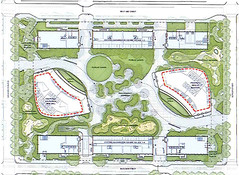At a meeting attended by Rosie Mendez and Margaret Chin last night, members of Community Board 2 spoke out against the scaled-back version of N.Y.U.’s controversial expansion plan that the two City Council members supported earlier this week.
Ms. Chin said she wanted to explain the “compromise” she helped work out, which she said reduced above-ground space associated with N.Y.U. 2031 by an additional 17.4 percent, or 212,000 square feet.
The modified plan would cut the Mercer Street building from 11 stories to four, and shrink the height of towers in the Zipper Building. Over all, according to Ms. Chin’s newsletter for her district, it represents a reduction of 26 percent or 352,000 square feet from the original proposal that was certified in January.
Residents last night were clearly disappointed that the City Council’s land use committee had approved the plan by a vote of 19-1, with the Council’s subcommittee on zoning also voting in favor of it. “I know people aren’t happy,” Ms. Chin said, to sardonic laughter. “It’s a compromise. But I want you to look at what we’ve been able to achieve with density and open space, because the City Council will vote on this issue.”
Despite that request, Ms. Chin got an earful from various board members and residents gathered in the auditorium of the Grace Church School for the last meeting of the summer.
Andrew Berman, executive director of the Greenwich Village Society for Historic Preservation, had placed leaflets on every folding chair calling Ms. Chin’s N.Y.U. compromise unacceptable and urging the public to call on her and Council Speaker Christine Quinn to withdraw their support before the full Council’s vote on July 25.
“N.Y.U. wasn’t entitled to any of this,” said Mr. Berman, presumably referring to the plan’s 1.9 million square feet of space. “The only reason they can do this is because the City Council gave them permission. The City Council has all the cards here. There’s nothing they could get unless the Council gave it to them.”
Hearty applause greeted both Mr. Berman’s remarks and those of Community Board 2 member Maury Schott, who said that the two committees had capitulated to N.Y.U. “The problem is that the open space was promised to the community years ago and in perpetuity, and now it has been taken away by a City Council that doesn’t have the backbone to say no,” he said.
Ms. Chin said she didn’t agree with the statement: “We’ve worked very hard to make sure that for the next 20 years, N.Y.U. will do what they’ve promised to do.” She said there was nothing else the Council could do.
The council members had already left the auditorium when Georgette Fleischer, a community advocate best known for opposing new liquor licenses in NoHo, took the microphone to protest the N.Y.U. expansion plan. “I can’t fathom how a University would want to build ugly buildings in one of the most beautiful neighborhoods in New York,” she said.
David Gruber, the new Community Board 2 chair, had joked earlier that the N.Y.U. plan was comparable to dropping the Mall of America in the Village. But his tone was somber when he proposed a second supplemental resolution opposing the university’s expansion. “The City Council votes on July 25 and there’s very little chance that we’ll get some movement on this,” he said. “But let’s arm ourselves with another resolution.”
With that, the Board unanimously voted to adopt a resolution that reiterates a previous one passed in April and calls for such measures as removing the Mercer Building entirely from the plan and narrowing the footprint of the Zipper Building, “to preserve the city-owned open space on Mercer.” The original resolution recommended denial of N.Y.U. 2031’s ULURP application and urged the Council to “protect our precious open space.”





